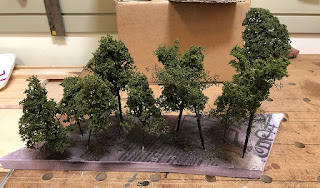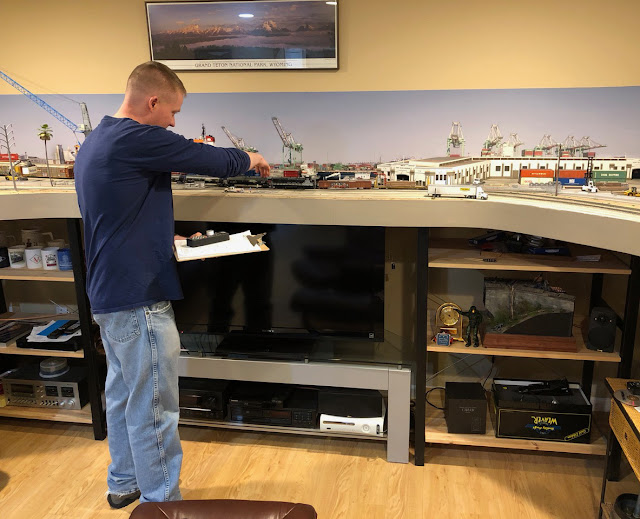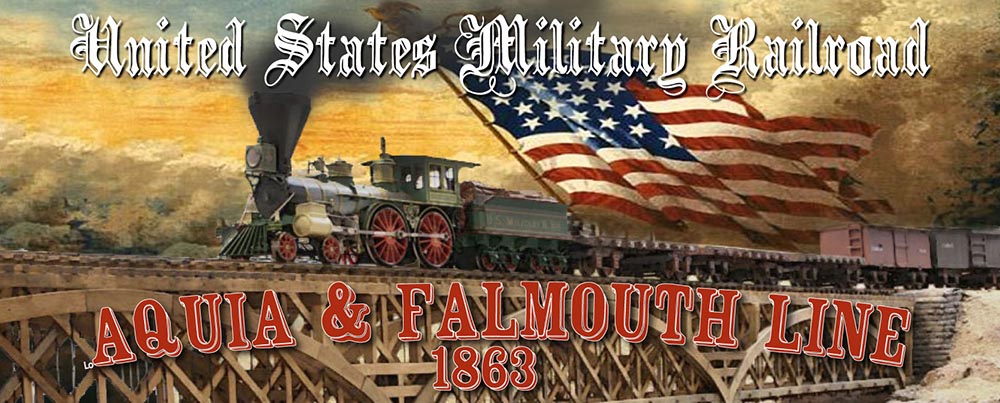 |
| Peter Clarke and Bob Rodriguez working the west end of Cortana yard. In the background is the operator, Bryan Kidd. |
If you ever met Pete LaGuardia, you would have no doubt about where he grew up. Pete has a thick New York, Bronx to be exact, accent. But behind that distinctive brogue is a delightful and generous man who has a wonderful model railroad. (see https://petelaguardia.wixsite.com/mysite). I had the opportunity to operate that railroad today.
Pete, in his infinite wisdom and generosity, assigned to me the job of Cortana Yardmaster. He said, "I gave you that job because I thought you'd like it." Classic Pete, always thinking of his guests first. But would it be a decision he regretted? Now, Cortana is the main classification yard for his railroad. It requires two engine crews and a yard master to run. Without a smooth running yard, the railroad could grind to a halt. Putting it in the hands of a first time boomer who is also a notorious night bug, for an early morning op session might be a formula for disaster. So what happened?
Let's take a step back and give a bit of background. Pete, as I mentioned above is a New York aficionado. His basement is decorated with all manner of New York artwork and memorabilia, including lots of New York Yankee souvenirs. Being a native New Yorker myself, actually a Brooklynite, and also a die hard Yankee fan, I fit right in. At one point as we compared notes, we discussed a native New York drink - the egg cream. The modern egg cream has neither eggs nor cream, but it was a delightful creamy chocolate flavored soda. It must be made fresh and consumed quickly. It doesn't bottle well, so it never really spread beyond New York.
Political side note, the current doings in New York make me hesitant to publicize my New York heritage. The New York of my childhood of the 1950s was a nice place to grow up. Every neighborhood was like a small town. People knew each other and looked out for each other. Each neighborhood was typically a distinct ethnicity that developed organically. Neighborhoods ebbed and flowed as people came and went. Most people got along and enjoyed what each neighborhood offered. It was a diverse and mind expanding place to live. However, by the late 1960s misguided policies lead to serious problems. Many neighborhoods decayed to graffiti covered wastelands awash with drug abuse. A dangerous place to attend high school. So my parents decided to leave. Later, the city underwent an amazing renaissance under Giuliani. His approach was to start with small problems, like cleaning up graffiti, and push up. It worked. I did a bike ride across the five boroughs in early 2000 and was amazed at how nice the city had become. I hope it can stay that way, though the distant news coverage is not promising.
 |
| John Swanson at Alfano |
Back to Pete's layout. Pete wanted to model the New York Central in the city with tall buildings and car floats. But, he also loved the Santa Fe Railroad. So he freelanced his railroad, naming many of the towns after his relatives. Being of Italian heritage, the towns sound like a line though Italy - Calamia, Alfano, Rinaldi, Cortana, etc. Great, now how to create an operating scheme that made sense? Enter Steve King. Steve is a legendary model railroad operations guru. For many years he actually worked as a dispatcher for a real railroad before becoming a consultant. Steve has written books on prototype and model railroads, especially,
19 East, Copy Three, which he cowrote with David Sprau. Steve helped Pete develop a realistic operating scheme for his freelanced railroad.
One of the key decisions was to decide where to place the railroad geographically. They came up with The Western Illinois Division of the New York Central. It would operate from Kansas City, Omaha, and Des Moines on the west, through Moberly (MO) and Hannibal (MO), to Danville (IL) and Indianapolis (IN) on the east. The car float operations were notionally on the Mississippi River. So Pete had his big city and Santa Fe passenger trains.
 |
Phil Raymond's veteran experience as east end switch crew
was quite helpful |
But Pete also had a confused yard master. While I am a student of geography, I had trouble figuring out where the various destinations were in relation to my assigned yard. Fortunately, Pete has provided excellent documentation both on the paperwork he emailed prior to the op sessions and on the layout to help boomers figure it all out. It took me a few minutes to digest all the info, including how to use the telephone to the operator. My yard crew, Pete Clarke (also a first timer on the Western Illinois Div) and Phil Raymond (a veteran on the layout) were very helpful in keeping things moving along. Mat Thompson, as the western staging yard master, and Bob Rodriguez, who ran several transfer runs into the yard, were also very helpful.
The Cortana Yard is huge, with seven classification tracks, two arrival-departure tracks, and two through tracks. So we had plenty of room to do the switching work that making and breaking the trains required, even for the 24-car train maximum limit. All in all, it worked very well. Pete has some added touches, like an automated double slip switch and the aforementioned telephone system, that simplified a potentially complex operation. There were several through trains, transfer runs and trains that originated in the yard, including a long local.
 |
| Coal mine across the aisle from Cortana yard |
I never got to see much of the rest of the layout but about a dozen other operators were busy doing their tasks. All in all an impressive model railroad.
After the session, Marie Ann, Pete's wife, provided a delicious lunch buffet of baked chicken, meatballs, and tortellini.

When I got home, I hung a portrait of Abraham Lincoln on the wall over my dispatcher's desk. Even though my associates on the ACWRRHS forum thought that a painting of Lincoln would be rare in a dispatcher's office, my brother decided to paint one for me for my birthday (or should I say our birthday, as we are twins). So there it is. It looks good. He did a nice job on the painting.

 Next we built some trees using Supertrees and some plastic styrene tubes. Mike's layout is set in the summer time. So he needs green trees. I have a lot of excess Supertrees so we used them to make a batch of deciduous trees.
Next we built some trees using Supertrees and some plastic styrene tubes. Mike's layout is set in the summer time. So he needs green trees. I have a lot of excess Supertrees so we used them to make a batch of deciduous trees.














